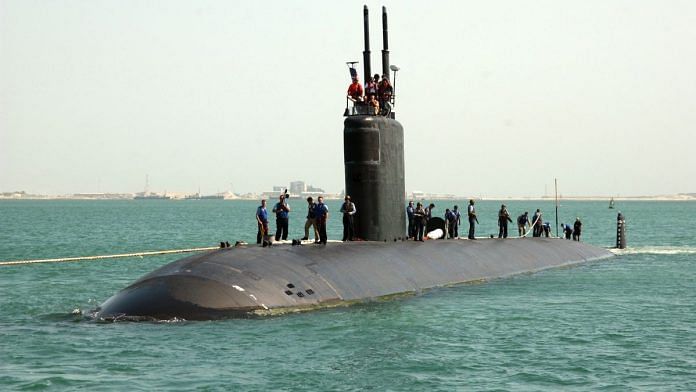
New Delhi: The much-hyped 2021 AUKUS deal, under which the United States and Australia have agreed to join hands on a nuclear submarine procurement and development project, could be in trouble with a US Congressional paper outlining the lack of capacity of the American shipyards and suggesting alternative plans.
The US Congressional Research Service, in its 10 October report, suggests that instead of building “up to eight additional Virginia-class SSNs (nuclear power attack submarines)” and instead of selling “three to five of them” to Australia, “these additional boats would instead be retained in US Navy service and operated out of Australia”.
“Australia — instead of using funds to purchase, build, operate, and maintain its own SSNs — would instead invest those funds in other military capabilities—such as, for example, long-range anti-ship missiles, drones, loitering munitions, B-21 long-range bombers, or other long-range strike aircraft—to create an Australian capacity for performing non-SSN military missions for both Australia and the United States,” the report says.
The US signed the AUKUS deal by pushing out France, which was in talks with the Australian side to sell 12 conventional diesel-electric submarines.
According to the AUKUS deal, the US Navy will rotationally deploy four own SSNs and one UK SSN out of a port in Western Australia, starting in 2027. Also, more significantly, the US Navy will sell three to five Virginia-class SSNs to Australia between 2032-2038 and, subsequently, build three to five replacement SSNs for itself.
The deal also entails the US and the UK helping Australia with an Australian effort to build an additional three to five SSNs of a new UK-Australian SSN design, with American technology, to complete a planned eight-boat Australian SSN force. However, the other suggestion by the US Congressional Research Service suggests completely forgoing even the new UK-Australian SSN design.
Under one variation in the US Congressional paper, the proposed sharing of US naval nuclear propulsion technology and US submarine technology, the proposed Australian investments in Australian and US submarine construction capability, and the other proposed actions for supporting eventual Australian construction of AUKUS SSNs would continue. Australia, the report notes, would eventually build its AUKUS SSNs, reducing the need for US SSNs to perform Australian SSN missions at that point.
Under another variation in the US Congressional paper, the performance of Australian SSN missions by US SSNs would continue indefinitely. Instead of implementing technology sharing, making Australian investments in submarine-construction capability, and taking the other actions needed to build AUKUS SSNs, Australia would continue investing in other military capabilities to support a continuing US-Australia division of labour.
According to the US Congressional paper, under this variation, the US SSN size would eventually expand above previously planned levels of eight boats, i.e., the proposed number of SSNs Australia had planned to acquire.
The AUKUS deal would have eventually cost Australia about USD 245 billion, and the US report now suggests the funds go towards procuring American systems instead.
The report notes that the US Navy has been procuring Virginia (SSN-774) class SSNs since FY1998, with 40 procured through FY2024.
From FY2011 through FY2024, the SSNs have been procured at a rate of 2 per year. Procured at this rate, they have an estimated procurement cost of about $4.5 billion each.
Despite being procured at a rate of 2 boats/year, the actual production rate has fallen short of 2 boats/year and, since 2022, has been limited by shipyard and supplier firm workforce and supply chain challenges to roughly 1.2 to 1.4 boats/year, resulting in a growing backlog of boats procured but not yet built.
The US Congressional paper adds that the US Navy and industry are working to increase the Virginia-class production rate to 2 boats per year by 2028 and, subsequently, to 2.33 boats/year to execute the two-per-year procurement rate and replace three to five Virginia-class boats, which the US is to sell to Australia under the AUKUS submarine project.
Incidentally, the US submarine and naval nuclear propulsion technologies are considered crown jewels of US military technology and, consequently, highly protected by it.
Given both its high degree of importance to overall American national security strategy and technical superiority in the field, the US, to date, has sold the nuclear propulsion technology with only one other country, the UK, through an arrangement in 1958 — built upon the trust created during the implementation of the Manhattan Project of World War II.
Four other American treaty allies, France, Italy, the Netherlands, and Japan, besides Canada and Pakistan, have unsuccessfully sought the same technology. In the past, the US has even rejected an earlier Australian request.
(Edited by Madhurita Goswami)
Also Read: US files charges against ex-RAW officer in Pannun case. FBI issues ‘wanted’ poster, may seek extradition